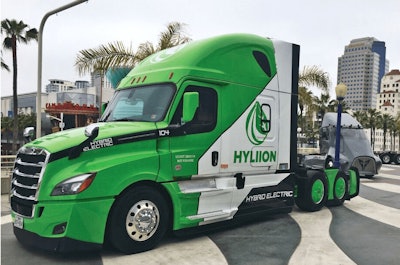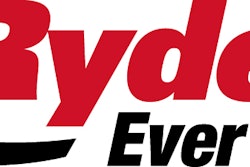
When it comes to preparing shops for hybrid powertrains, it’s best to get ahead of the curve, according to Purkeys Founder and Chief Creative Engineer Bruce Purkey.
“Don’t wait until these vehicles are in your yard. Start making plans now. You can’t wait until they get there,” Purkey said recently during a 48-volt hybrid panel discussion at ATA’s Technology & Maintenance Council (TMC) Annual Meeting in Atlanta.
While hybrids vary, the general consensus at TMC is that a 48-volt system makes the most sense for larger class trucks. Benefits? Upfront costs are lower for a mild hybrid, which invites a faster ROI; fewer battery cells means less weight; and 48 volts is below the 60-volt threshold for high-voltage, which means safer working conditions. But keep in mind that low voltage systems can be dangerous, too. “It is not the voltage that kills. It is the current. A small current of 500 mA can stop a heart,” says Prof. John Frala, who instructs classes on alternative fuels including electric and fuel cell vehicles at Rio Hondo College in Whittier, Calif.
Safe working conditions, of course, come from knowing vehicle architecture and, in the case of hybrids, the learning curve is higher where there are more working parts and components than an electric vehicle (EV).
“Hybrid systems have two power sources to deal with,” Frala says. “Most have some form of Atkins cycle gasoline engines or in the truck market a small diesel, such as a 5.9-liter Cummins, incorporated with a small or dual electric motor.
“Most hybrids use a dual planetary carrier in the transmission,” Frala continues. “A full electric has one gear direct drive and varies output by changing the fields within the electric motor. Depending if the full electric is using a synchronous or asynchronous engine the power output will vary to the drive axle.”
In the case of the mild 48-volt hybrid discussed last month at TMC, the system works alongside existing 12-volt architecture, sparing the added expense of upgrading all electronics to 48 volts.
But there are plenty of challenges too, according to Purkey, who notes that steps need to be taken with wiring and component identification to clearly differentiate one voltage system from another. Color coding and labeling can help, Purkey says.
But knowing the differences in voltages is only one piece of the puzzle. How a 48-volt system is tested may vary.
“It really depends on how the OEM will construct the battery pack. If four group 31 in series, the actual testing will be done on the individual battery with the same test equipment once the batteries have been disconnected,” Purkey says. “In the past, batteries in series must always be replaced as a system unlike batteries in a parallel system.
“If the OEM chooses to use a single 48-volt battery pack made up with cells, this pack will take special testing equipment not available at the present time. As with all new technologies, the special equipment will take training,” Purkey adds.
Besides lowering fuel consumption and emissions, the higher voltages in a hybrid require smaller gauge wires. Also, alternators, starters or any electric motor operating at a higher voltage will be smaller and weigh less because less wiring is required.
“Conduction voltage drop test on these higher voltage systems would require revised or newly designed equipment, but the test procedure would be the same,” Purkey says. “The starter and alternator could be a combined motor/generator or could be a system built into the transmission. These types of systems would obviously require training on how to troubleshoot and repair or replace.”
A higher voltage level also will invite additional corrosion concerns, which he says will make ground and wire connections all the more important.
“Fleets will have to pay particular attention to making proper repairs that are totally sealed to ensure long-term integrity of the repair,” Purkey says, adding a TMC recommended practice regarding wire repair up to 48 volts is in production.
Putting safety first
Dana and Hyliion made headlines in March by revealing the industry’s only Class 8 hybrid truck. Fleet interest continues to build for the 6X4HE, which has received positive reviews for its increased fuel economy, lower emissions and reasonable upfront cost that delivers ROI in roughly two years.
While the 6X4HE may eventually be offered as a factory-installed option, it’s currently offered as a retrofit (it was revealed in a Freightliner Cascadia) and features high- and low-voltage circuits. Torque boost comes courtesy of Dana’s high-voltage 300-amp electric e-Axle in the rear.
Dana is providing motors, inverters, controls, gearboxes and thermal management technologies for the 6X4HE, and recently published videos offering safety tips for working on high-voltage commercial vehicles. While the videos focus on all-electric powertrains — voltage shows no bias for the application — safety must come first whether working on a hybrid or all-electric system.
The short but informative videos, hosted by auto celebrity Jessi Combs, provide some much-needed insight into vehicle electrification along with all-important safety tips. The titles read like a popular FAQ list: Electric Vehicle Architecture Overview, Electric Vehicle Maintenance Schedule, Submerged Electric Vehicle Protocol and Electric Vehicle Maintenance Safety Tips.
It’s that last video that really shows the stark difference between vehicle electrification and the greasy world of internal combustion engines with, of course, the hybrid service tech taking on both.
“Before we jump in, we must put you on a high-voltage alert. The blue, orange and yellow EV wires are the highest of voltage so you must be careful,” says Combs while wearing an arc-rated blue jump suit, arc flash hood, face shield, two sets of gloves and electrically-rated shoes.
Combs advises viewers that Dana’s safety tips are intended to serve as an overview and should not override a shop’s policies or procedures or the OEM’s guidelines.
The Hybrid Shop, a franchise based in Los Angeles that is extending its hybrid and EV maintenance and repair services to commercial trucks and vans, supports Dana’s safety recommendations.

In the video Combs echoes Kruszelnicki’s sentiment. “This might seem a little excessive, but hear me out,” she says. “An arc blast is four times the temperature of the sun and the gear inside your arc flash kit can help protect you from that.”
Combs doubled up on gloves for extra protection: An outer pair of leather gloves covered insulated electrical gloves which are categorized based on voltage levels and will be needed until the vehicle’s system has been safely deenergized.
“Class 00 gloves are for mid-level voltages up to 500 volts DC. Class O gloves are up to 1,000 volts DC,” Frala says. “So, to disconnect a Prius 125vDC msd you need gloves. From that point on no gloves are needed unless a welded contactor is suspected.”
Ram’s 1500 eTorque features a 48-volt battery that provides boost to the powertrain with electric assist. Brian Spohn, manager of Ram’s vehicle electrification, explains that since its mild hybrid is not all-electric but, instead, has a common ground, personal protective equipment is not required like it is on a high voltage EV or PHEV. But before the hood goes up, techs must undergo training.
“On top of the current training for the Ram 1500, FCA Performance Institute initiated a special course on the eTorque mild hybrid and how to service/diagnose the system,” says Brian Szalk, Ram head of technical training. “We established this course as an on-line resource in different languages for quick proliferation and constant access. Technicians must complete the course before servicing the e-torque system.”
One of the lessons that techs receive focuses on cable colors. An electrified vehicle at or below 60 volts uses blue cable on the motor generator unit (MGU). Anything above that amount would use orange cable.
“The Prime Power Unit and MGU carry protective measures for voltage control,” Spohn says. “In all electrification powertrains, installation and removal must follow the ordered procedure.”
Tooling up for hybrids
Ever see a portable 48-volt battery charger? Probably not. As Purkey mentions, the OEMs’ decisions on delivering a 48-volt battery system (whether by stringing 12-volt batteries together or by offering a single 48-volt battery) will determine equipment selections. While multimeters aren’t a concern, analyzers will require new loads and boards, he says.
However, at this point, save for Hyliion’s 6X4HE, it’s just too early to run out and buy additional equipment. Eaton’s 48-volt hybrid system, which was on display at TMC, is still under development.
How big of a leap will it be for shops to transition to Eaton’s mild hybrid?
“Not big, because you’re still dealing with standard engine and transmission,” says Carl Smith, Eaton manager of applications engineering of commercial vehicles and Mil Aero. “The air conditioning stays the same. The PTO and motor drive are new components. They’re both serviceable parts. Obviously, there will be some training on that part of it, but right now, nobody in any high volume is running any 48-volt systems.”
Hyliion Founder and CEO Thomas Healy says fleets won’t be up against that much of a transition when it comes to taking on hybrid trucks.
“One of the great things about hybrid systems compared to a normal diesel truck is that the tooling and maintenance requirements don’t vary that dramatically,” he says. “This is one of the key benefits of shifting to hybrid electrification. While we can’t speak to other hybrid systems, the Hyliion 6X4HE was designed to use the same standard set of tools available in any normal shop.”
The biggest challenge in working with electrified vehicles, Healy says, will be in prepping technicians on how to work safely around higher voltages.
“Training on appropriate personal protection equipment and high voltage disconnection is critical. Site inspections and evaluating unusual wear and tear is something that a maintenance team could add to their normal care routines,” Healy says. “Additionally, ensuring that shops are outfitted with appropriate emergency equipment, such as a Class ABC fire extinguisher in the unlikely event of a fire, will be important. As an additional precaution, Hyliion uses a battery chemistry for the Hyliion 6X4HE that is designed to be non-combustible and the batteries are designed to disintegrate if the battery enclosure is penetrated.”
ZF Friedrichshafen provides electrification options for cars, trucks and buses that range from a mild hybrid to all-electric. Like other leading manufacturers, ZF believes that all-electric and hybrid drivelines are key to the industry’s future. This year, European truck maker DAF, a subsidiary of Paccar, will be using ZF’s TraXon transmission in a high-voltage hybrid system. ZF will provide training and tooling.
“As part of our service-ready strategy, we will be offering specific high voltage training to make work-ing on HV systems safe for our end users,” says Dirk Fuchs, ZF technical training manager. “This training will aim at safely discharging the 400-volt system and confirming zero state potential before any repairs are made. The training shall also instruct how to correctly use the HV tooling and emphasize the need to maintain the test equipment, it’s calibration and understanding the dangers of badly maintained tooling.”










